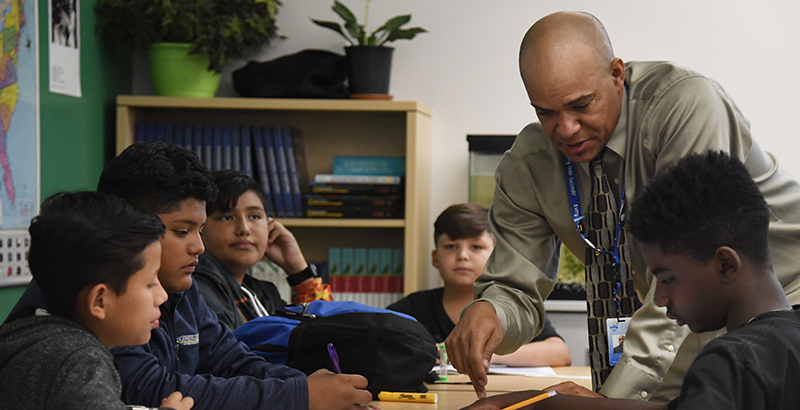New Research: Hiring More Teachers of Color and Raising the Teacher Hiring Bar Not Mutually Exclusive

There are two vital but seemingly competing efforts afoot to remake the teaching profession in the U.S.: attracting more teachers of color and diversifying the teaching corps while also raising the rigor of those who start in the profession.
States and teacher preparation should do both, researchers with the liberal Center for American Progress argue in a report released earlier this month.
Having teachers of color is essential, given that studies have tied same-race teachers to better academic achievement among students and reduced discipline referrals. Black and Latino students are more likely to be identified as gifted by teachers of their own race.
At the same time they worried about diversifying teaching, policymakers and researchers have focused on turning it into a more selective profession, in an effort to boost American students’ falling international test scores as compared with those in other countries that make becoming a teacher more difficult.
(The 74: Raising the Bar Might Bar Too Many When It Comes to Teacher Certification Tests)
“Many educators, policymakers, and other stakeholders worry that increasing selectivity may lead to a less racially diverse teacher workforce, as minority candidates generally score lower on many of the current selectivity metrics used by teacher preparation programs. Others maintain that the diversity gap will only continue to grow in the decades to come, even with a focus on the recruitment and retention of the current generation of prospective teachers,” the CAP researchers wrote.
The think tank also released new research Thursday highlighting the growing disparity between the number of students of color and the number of teachers, and held a panel discussion in Washington with educators focused on diversifying the profession.
CAP researchers did similar studies in 2011 and 2014. The number of nonwhite students has increased since then, hitting more than half in 2014, but the number of nonwhite teachers has not kept pace. The teaching force is still about 80 percent white.
(The 74: How Denver Is Tackling the ‘Invisible Tax’ on Black Educators)
Of the 19 states researchers looked at, California had the largest gap, at 40 points. Three-quarters of students in the state are children of color, but just 35 percent of teachers are nonwhite, as of the 2014–15 school year.
Other states with big gaps included Illinois (34 points), Texas (33 points), and Florida (31 points).
Casey Bethel, a high school science teacher and the 2017 Georgia Teacher of the Year, refuted the idea that high expectations and a diverse teaching force are necessarily at odds.
It’s just not true that there aren’t enough potential teachers of color who could meet high benchmarks, he said at the CAP panel Thursday.
“It’s not that we don’t have qualified people in these groups. The question is, how early do we have to attract them, and what message do we have to give them?” he said. “We can do these two things together — they’re not competing [against each other].”
There’s data in the CAP paper to back that up.
Researchers found that changes to entrance exams for teacher preparation programs didn’t affect the percentage of prospective teachers of color in eight of nine states. In most states, the increased percentage of those prospective teachers tracked with an overall increase in students of color attending college. In four states — Georgia, Iowa, Oregon, and Rhode Island — the increase in prospective teachers of color actually outpaced the growth among students of color more generally, the report states.
Teach for America, too, has been successful in diversifying its corps, from 29 percent people of color in 2008 to 50 percent in recent years, even as it maintains an acceptance rate of about 15 percent, Josh Anderson, head of the organization’s recruitment and admissions, said at the panel.
“This is essential. It’s not important among other things, it’s essential and central to the whole thing,” he said of having a diverse pipeline of recruits.
TFA is intentional about its recruitment strategy, making sure to invest heavily at historically black- and Hispanic-serving institutions, and ensuring that candidates of color aren’t falling out of the application process, he said.
Many of the same issues plaguing teacher recruitment in general are also problems when it comes to finding teachers of color: issues like low salary or stressful working conditions, the panelists said.
There are some specific issues, though, the panelists noted. Few potential teachers of color would consider being teachers if they had bad experiences in school themselves as children. And unlike, say, young white girls, who might have teaching pitched to them as a profession as early as kindergarten or first grade, many teachers of color, particularly men, don’t have it suggested until they’ve graduated from college, said Sharif El-Mekki, a principal in Philadelphia and founder of The Fellowship: Black Male Educators for Social Justice.
It’s critical both for students of color, and for white students, who should have the chance to learn from diverse adults, to recruit more teachers of color, Bethel said.
“This isn’t optional. This is necessary. We have to be intentional about recruiting a diverse teacher population,” he said. “I can’t promise you right now that we’re doing a good job.”
Get stories like these delivered straight to your inbox. Sign up for The 74 Newsletter

;)
